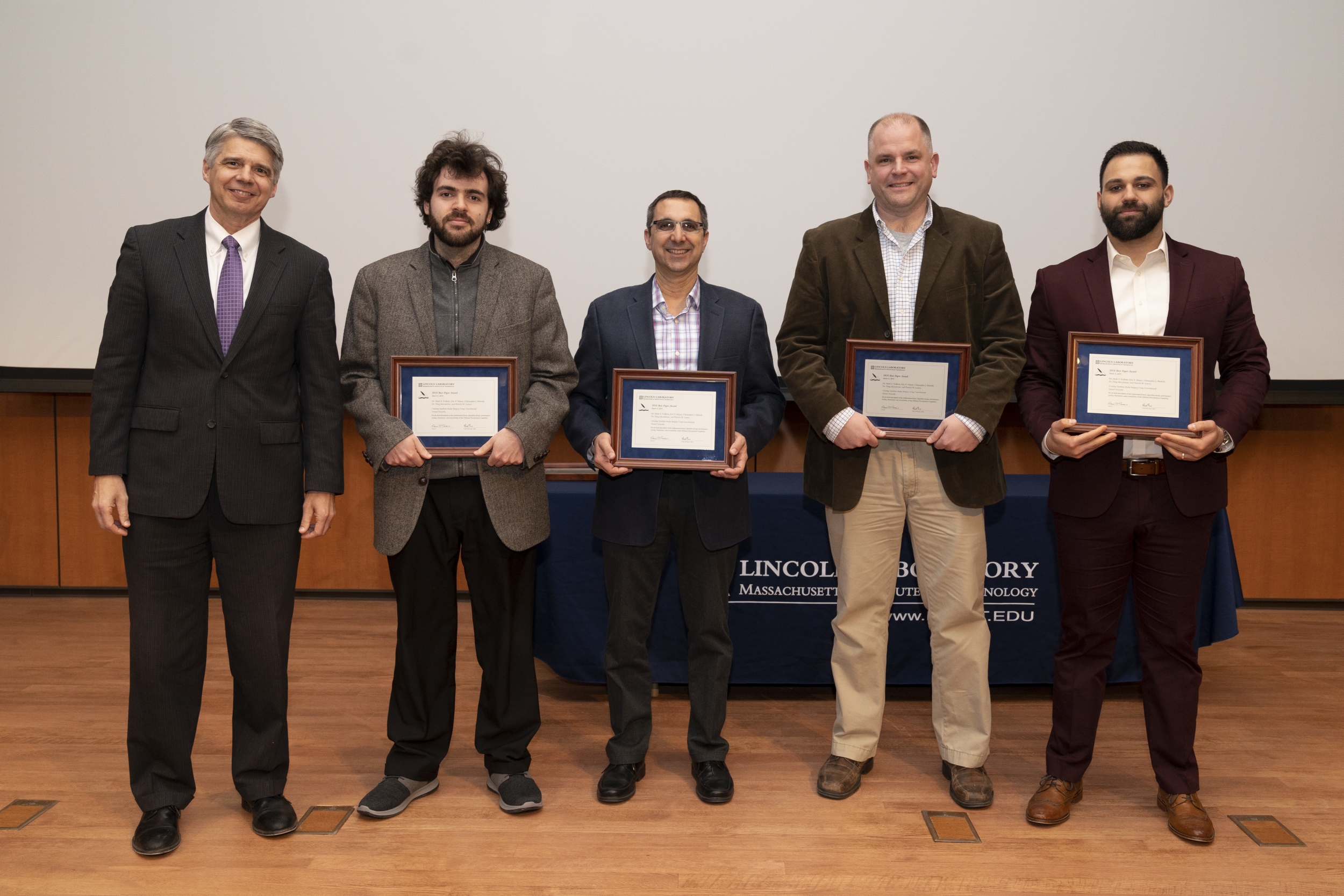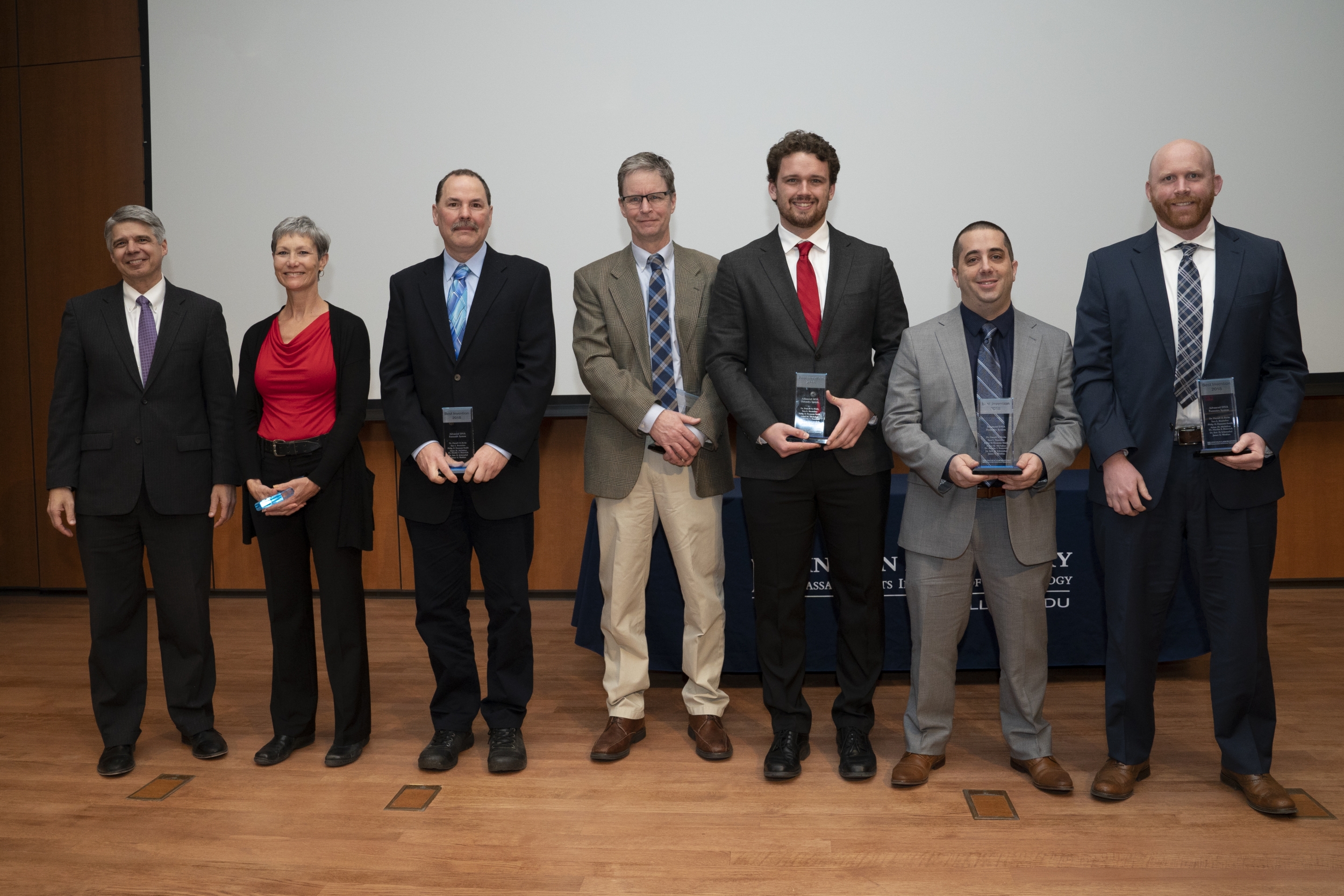2018 MIT Lincoln Laboratory Technical Awards
Technical Excellence Awards
James K. Kuchar
For sustained leadership and technical contributions in the development, integration, and testing of air traffic control and other transportation-related systems, and for innovative work in collision avoidance and risk assessment.
Dr. James K. Kuchar is the Leader of the Air Traffic Control Systems Group at MIT Lincoln Laboratory. He has responsibility for the research and development of integrated sensing and decision support systems to improve aviation safety and efficiency. He oversees a range of transportation programs that encompass weather sensing and forecasting, machine learning techniques to optimize traffic management, human systems integration, and processing architectures. Two recent highlights from his group include the development of technology that has the ability to generate rapidly updating precipitation mosaics beyond the range of ground-based radar, and the creation of a statistically based weather-impact forecast to inform air traffic flow decisions. These new capabilities are slated to be incorporated into the Federal Aviation Administration’s (FAA) next-generation weather processing architecture, which was itself prototyped in Jim’s group.
Jim joined Lincoln Laboratory in 2003 after having served on the MIT faculty for eight years in the Department of Aeronautics and Astronautics. At the Laboratory, Jim led the development of a collision risk-analysis framework for manned and unmanned aircraft that is based on statistically representative airspace encounter models. These models have become international standards in the development of collision avoidance systems. The analysis framework was subsequently applied to validate algorithm improvements for the collision avoidance system currently deployed worldwide on more than 30,000 aircraft and has served as the foundation for the development of the next-generation collision avoidance system, ACAS X, which will become operational in 2020.
Jim serves on the FAA’s Research, Engineering, and Development Advisory Committee. He is an Associate Fellow of the American Institute of Aeronautics and Astronautics (AIAA) and associate editor of the AIAA Journal of Air Transportation. A private pilot, he has coauthored more than 110 reports, including 70 refereed journal and conference papers. Jim holds SB, SM, and PhD degrees in aeronautics and astronautics from MIT.
Michele A. Schuman
For exceptional leadership and a wide range of contributions to the field of radio frequency satellite communications, including system design and analysis, algorithm development, and system integration and test.
Dr. Michele Schuman is the Leader of the Advanced SATCOM Systems and Operations Group at MIT Lincoln Laboratory. She directs efforts to enhance the capability, resiliency, and flexibility of future generations of Department of Defense space communications (SATCOM).
At the Laboratory, Michele has served in a wide range of technical roles, ranging from algorithm developer, system analyst, prototype system integration and test lead, and system architect. She developed spatial acquisition and tracking algorithms for satellite terminals and time-
frequency acquisition algorithms for a new frequency-hopping, anti-jam satellite waveform. She led the integration of the Advanced Extremely High Frequency (AEHF) Interim Command and Control Terminals for the U.S. Air Force. These terminals, operational for more than 10 years, underpin the highly assured SATCOM system for the nation’s nuclear weapon forces.
Michele has conducted analysis and development on satellite and line-of-sight communication capabilities. She led the creation of tools and techniques to rapidly evaluate the resiliency of all types of communications systems to current and emerging jamming and detection threats. Her team’s analysis of threats to SATCOM led to a satellite surrogate program at Lincoln Laboratory under the PACECR program, which successfully demonstrated a multinode air layer, and the Protected Anti-Jam Tactical Service SATCOM program, which begins operational fielding in 2023.
Michele joined Lincoln Laboratory in 2004 after earning a PhD degree in mathematics from the University of California San Diego. She holds a BS degree in electrical engineering, a BS degree in mathematics, and a BA degree in French from the University of Wyoming, and an ME degree in electrical engineering from the University of California. She is a member of the Department of Electrical and Computer Engineering Advisory Board for the University of Wyoming.
Early Career Technical Achievement Awards
The Early Career Technical Achievement Awards recognize significant technical contributions by individuals under the age of 35.
Danelle C. Shah
Dr. Danelle C. Shah, for her contributions to the research and development of data analytics, machine learning, and artificial intelligence techniques. Danelle is a technical expert in the application of advanced data science and automation for intelligence and decision support. She has applied her skills across multiple projects and missions, including intelligence, surveillance, and reconnaissance; humanitarian assistance and disaster relief; and education in science, technology, engineering, and math.
Thomas Sebastian
Dr. Thomas Sebastian, for his innovative new concepts in aerospace systems, including micro–unmanned aerial vehicles (UAVs), thermal management of high-energy lasers, and biodefense sensors. Thomas is a technical expert in aerodynamics and aero-system design. Recently, he led the development of a low-acoustic-signature propeller for UAVs and helped demonstrate the world’s first electro-aerodynamic propulsion system.
Best Paper Award
The Best Paper Award recognizes the MIT Lincoln Laboratory author(s) of the most outstanding published paper appearing in a peer-reviewed journal or peer-selected conference publication during the year preceding the award announcement.
Dr. Mark S. Veillette, Eric P. Hassey, Christopher J. Mattioli, Dr. Haig Iskenderian, and Patrick M. Lamey

For “Creating Synthetic Radar Imagery Using Convolutional Neural Networks,” which was published in the Journal of Atmospheric and Oceanic Technology, vol. 35, no. 12, December 2018.
This paper is recognized for its lucid description of the mathematical basis, algorithm design, performance testing, limitations, and extensibility of the Offshore Precipitation Capability.
Best Invention Award
The Best Invention Award recognizes the most significant new device, method, or process developed by MIT Lincoln Laboratory researchers from study or experimentation. Inventions resulting in a filed technology disclosure, patent application, or patent license within the previous two years are given preference, though inventions not suitable for patenting are considered.
Dr. Darrell O. Ricke, Tara L. Boettcher, Philip D. Fremont-Smith, Adam M. Michaleas, Dr. Martha S. Petrovick, Dr. Eric D. Schwoebel, and James G. Watkins

For the invention of Advanced DNA Forensics System, which is associated with 21 technology disclosures that were filed between 2013 and 2018.
The Advanced DNA Forensics System incorporates ultrafast computational methods for searching DNA databases and advanced forensics for complex DNA mixture analysis. This invention enables the rapid comparison of DNA samples from individuals and mixtures against a large DNA profile database and provides improved statistical confidence measures. The DNA forensics can be performed on a laptop for multiple military and criminal justice applications, has been transitioned to FBI Quantico R&D, and will continue to have an important and expanding impact on national security.



